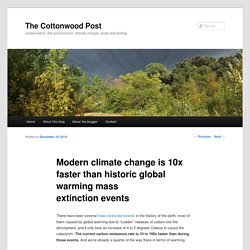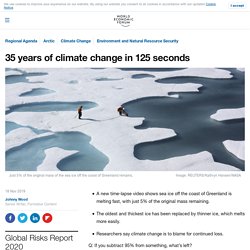

Antarktis smälter i rekordfart: Stora förändringar på nio dagar. Modern climate change is 10x faster than historic global warming mass extinction events. There have been several mass extinction events in the history of the earth, most of them caused by global warming due to “sudden” releases of carbon into the atmosphere, and it only took an increase of 4 to 5 degrees Celsius to cause the cataclysm.

The current carbon emissions rate is 10 to 100x faster than during those events. And we’re already a quarter of the way there in terms of warming. The current warming trends, RCP 8.5 and RCP 4.5, refer to estimates of carbon emissions under high and moderately low projections by the International Panel on Climate Change. The straight lines on the extinction events are approximate; there may have been episodic spurts and stops as different thresholds, positive feedback loops, and other natural events occurred. But these lines connect the dots we have. The earth is 4.5 billion years old. The End-Triassic extinction event came next, 201 mya. Finally, there was the Paleocene-Eocene Thermal Maximum (PETM) and associated extinction event 56 mya. Ten impacts of the Australian bushfires. 1.

Physical, direct impacts Over 18 million hectares have burned in the Australian bushfire season 2019–2020 as of mid-January according to media reports, destroying over 5,900 buildings including over 2,800 homes. In addition to human fatalities, many millions of animals are reported to have been killed. 2. Ongoing ecological and biodiversity impacts After initial devastation of the fires, impacts are ongoing. 3. As a result of intense smoke and air pollution stemming from the fires, in January 2020 reports indicated that Canberra measured the worst air quality index of any major city in the world. 4.
Smoke from wildfires can travel great distances. 5. Fires do not only cause physical harm; many people experience mental trauma from the experience of emergency evacuation and losing homes, pets, belongings, livestock or other sources of livelihoods. 6. 7. The bushfires have not only been made more likely and intense by climate change, they also add to it. Chasing climate change – Spesial. New time-lapse video shows how fast the Arctic Ocean’s oldest sea ice is melting. A new time-lapse video shows sea ice off the coast of Greenland is melting fast, with just 5% of the original mass remaining.

The oldest and thickest ice has been replaced by thinner ice, which melts more easily. Researchers say climate change is to blame for continued loss. Q: If you subtract 95% from something, what’s left? A: An environmental crisis. The "something" in question is the oldest and thickest solid layer of frozen water in the Arctic Ocean, which is melting so rapidly that just 5% of its original mass remains. Scientists from the American Geophysical Union (AGU) have released a time-lapse video showing the ocean’s ice forming and receding over the past 35 years.
The region – which covers a 2,000 km arc from the western Canadian Arctic Archipelago to the northern coast of Greenland – will be the last to lose its perennial ice cover, climate models suggest. But sea ice cover here is melting twice as fast as other places in the Arctic Ocean. License and Republishing Written by. Bushfires live updates: Troops prepare for emergency evacuations by sea.
A hot air mass is moving across the country, with extremely hot and dangerous conditions for fires due to lash South Australia tomorrow then NSW and eastern Victoria on Saturday.

Sky News meteorologist Alison Osborne outlined the dangers of the weather pattern to news.com.au, saying the fires in these conditions will become "unpredictable, uncontrollable and fast moving". "The southern regions of SA will experience very hot and windy conditions," she said. "Temperatures well into the 40s and strong winds in a north to north westerly, shifting to a south-westerly from west to east with the passage of the front. "The change won’t hit the fire-ravaged Mount Lofty Ranges until after sunset, making for another challenging day. " "Temperatures across the already stricken areas of Eastern Victoria, the NSW southern Ranges and the South coast will climb to the 40s in the north-westerly winds ahead of the cool change," she said.
"It’s a similar synoptic setup to New Year’s Eve. “Vi håller på att stänga dörren till 1,5 grad” - Studio Ett. How to Halt Global Warming for $300 Billion.